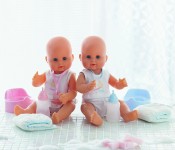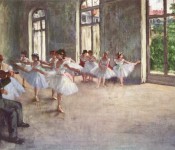
Dress-Up
Contributor: Storey Zimmerman
Also by this contributor: “PG-13 Movies”
The only specific memory I have of Pre-Kindergarten is of the legendary purple dress. The purple dress was my favorite plaything in the toybox at school. Whenever we would be released for recess, I, along with almost every other girl in our class, ran straight to the dress-up area to grab the purple dress. My best friend, Su, and I fought over the purple dress almost constantly, resorting to violent outbursts at some points just so we could be the one in the pretty dress. Eventually, our teacher had to designate specific days when the dress would be mine, and other days when the dress would be Su’s. We were obsessed with this dress and looking pretty.

Baby Dolls
Contributor: Elizabeth Webster
Also by this contributor:“Abercrombie & Fitch”
I am one of many girls throughout the decades and across cultures who has been influenced by countless hours of interacting with baby dolls. Today’s baby dolls resemble real babies in multiple aspects – their features, body structure, and even noises are designed to both entertain and encourage nurturing skills in young girls. But baby dolls have not always served this purpose. The history of baby dolls dates all the way back to the ancient civilizations of Egypt, Greece, and Rome where they were used for magic and religious rituals instead of play. In these days dolls were made from clay, wood, bone, and ivory – materials not suited for cradling or cuddling as they are today.[1]

Ballet
Contributor: Madison Hart
From the age of three until my sixteenth birthday, dance was my life. By the age of eight, I was in a prestigious dance company. By the time I was fourteen, I had danced in competitions and performances in New York, LA, and everywhere in between. To put it simply, when it came to the dance world, I had seen it all. Stage moms were all I knew, and false eyelashes were as much a part of my life as Barbie dolls were.

The Little Mermaid
Contributor: Emily Garza
Also by this contributor: “Britney Spears”
“It’s she who holds her tongue who gets a man.” Would you give this piece of advice to your daughter? How about your sister? No, I don’t think anybody would. This isn’t a very good message to tell any girl, yet it’s an exact quote from a very popular children’s movie: Disney’s “The Little Mermaid”[1](1989). I decided to go back and re-examine “The Little Mermaid” and analyze just what kind of messages the movie sends, because honestly when I was six years old there’s nobody who I wanted to be more than Ariel. She was everything a young girl ought to be: beautiful, fun, energetic, and she was a princess! I actually have quite vivid memories of swimming in a pool (and the bathtub to be honest) and pretending I was the little mermaid herself. I would have given anything to be my favorite Disney Princess.

Barbie
Contributor: Carol Perales
Also by this contributor: “Sex and the City”
Who wouldn’t want to look like Barbie? With her perfect hair, long legs and thin waist. At the age of twenty-one and having already reached my full body growth, I have to accept the fact that I will never fit this image. My genetics have decided not to take the Barbie route. Barbara Millicent Roberts, fondly known as Barbie, was introduced in 1959 by Mattel.[1] She has successfully been assisting girls in the art of play and fashion for years. However, there has been controversy that Barbie portrays an unhealthy, unattainable body image and has an overly sexualized figure. It can also be argued that Barbie allows girls to learn about a variety of available occupations as well as striving to be independent young women. Therefore, is Barbie really just a simple doll or are young girls receiving messages from these toys as to how to interpret body image?

PG-13 Movies
Contributor: Storey Zimmerman
Since 1968, the Motion Picture Association of America, or MPAA, has been rating movies. Jack Valenti, the longtime President of the MPAA, felt that there needed to be some organization of censoring instead of the mishmash of censorship boards that existed before. There were over 45 censorship boards when the ratings were set in place.[1] Filmmakers were required by the states to send their movies to each of the boards and get approval before being able to release them. In an interview, Dan Glickman, CEO of the MPAA, said “Jack determined that we needed to put some order and structure to this system to give parents some predictability. He felt, rightly so, that the prime purpose of ratings were to give parents information about movies.”[2]

MySpace
Contributor: Sara Robillard
With the commercialization of the Internet, various social networking sites sprang up virtually overnight. The most significant, MySpace, shook the parenting world. MySpace represented vastly uncharted territory to concerned adults; it seemed to be a labyrinth of pictures of scantily clothed children who willfully allowed strangers access to their home addresses, phone numbers, and personal lives. Launched in 2003, MySpace peaked in 2006 with more than 100 million registered members worldwide. MySpace, originally sold for $580 million, was the first social networking site to make a dramatic impact on parents and their young children. [1] Read more 

Abercrombie & Fitch
Contributor: Elizabeth Webster
Every year around Christmas time, thousands of teenagers beg their parents for the latest clothes from the well-known trendy retail store, Abercrombie and Fitch. In 2003, parents were not so easy to convince. Just days before the grand start of the Christmas shopping season, Abercrombie & Fitch, suffering from numerous boycotts, ordered its 651 stores to stop selling the latest edition of their A&F Quarterly titled “The Christmas Field Guide.” These boycotts were the result of the forty-five overtly sexual images in the first 120 pages of the magazine.[1] Read more 

Harry Potter
Contributor: Hannah Vickers
Growing up, being the youngest of four girls and a daughter of a pastor, my sisters and I never really were allowed to view a great deal of violence on TV, so besides the occasional hair pull, or a slight shove now and then, we were oblivious to the harshness of reality. Our games, books and movies were filled with the usual Disney storyline that always ended with a happily-ever-after. PBS was a must, and anything outside of our little town of Cut-N-Shoot, Texas was blurred by a force field of safety. But, even the strongest parental protection over us could not shield us from a worldwide phenomenon that touched American children in 1997—the magical world of Harry Potter. Read more 

“Beavis & Butt-head”
Contributor: Devon Tincknell
Beavis: Hey Butthead, what did people do before they invented TV?
Butthead: Don’t be stupid, Beavis. There’s always been TV. There’s just more channels now.
Beavis: Oh yeah, (snickers), progress is cool.
– “Beavis and Butt-head,” Killing Time
Debuting on MTV on March 8, 1993, Beavis and Butt-head quickly became two of the nineties’ most iconic characters.[1] Created and voiced by Mike Judge, the duo’s self-titled series was the Seinfeld of low-brow animation, yet another “show about nothing.” Most of the series’ short vignettes centered around Beavis and Butt-head heckling MTV, using television to determine what was “cool” and what “sucked,” and chortling incessantly, all while completely bereft of adult supervision. Read more 






